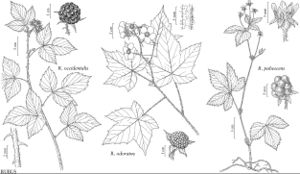Difference between revisions of "Rubus occidentalis"
Sp. Pl. 1: 493. 1753.
FNA>Volume Importer |
imported>Volume Importer |
||
| (6 intermediate revisions by 2 users not shown) | |||
| Line 13: | Line 13: | ||
}}{{Treatment/ID/Special_status | }}{{Treatment/ID/Special_status | ||
|code=F | |code=F | ||
| − | |label= | + | |label=Illustrated |
}} | }} | ||
|basionyms= | |basionyms= | ||
| Line 31: | Line 31: | ||
|elevation=0–1000 m | |elevation=0–1000 m | ||
|distribution=N.B.;Ont.;Que.;Ala.;Ark.;Colo.;Conn.;Del.;D.C.;Ga.;Ill.;Ind.;Iowa;Kans.;Ky.;Maine;Md.;Mass.;Mich.;Minn.;Miss.;Mo.;Nebr.;N.H.;N.J.;N.Y.;N.C.;N.Dak.;Ohio;Okla.;Pa.;R.I.;S.C.;S.Dak.;Tenn.;Vt.;Va.;W.Va.;Wis. | |distribution=N.B.;Ont.;Que.;Ala.;Ark.;Colo.;Conn.;Del.;D.C.;Ga.;Ill.;Ind.;Iowa;Kans.;Ky.;Maine;Md.;Mass.;Mich.;Minn.;Miss.;Mo.;Nebr.;N.H.;N.J.;N.Y.;N.C.;N.Dak.;Ohio;Okla.;Pa.;R.I.;S.C.;S.Dak.;Tenn.;Vt.;Va.;W.Va.;Wis. | ||
| − | |discussion=<p>Rubus occidentalis is the source of most of the black raspberries in cultivation. See 13b. R. idaeus subsp. strigosus for discussion of application of the name R. neglectus. Also, see 17. R. leucodermis for a discussion of its taxonomic closeness. The morphologically similar species R. eriocarpus Liebmann is known from southern Mexico and Central America, and R. pringlei Rydberg is known from Mexico and Guatemala.</p> | + | |discussion=<p><i>Rubus occidentalis</i> is the source of most of the black raspberries in cultivation. See 13b. <i>R. idaeus </i>subsp.<i> strigosus</i> for discussion of application of the name R. neglectus. Also, see 17. <i>R. leucodermis</i> for a discussion of its taxonomic closeness. The morphologically similar species R. eriocarpus Liebmann is known from southern Mexico and Central America, and <i>R. pringlei</i> Rydberg is known from Mexico and Guatemala.</p> |
|tables= | |tables= | ||
|references= | |references= | ||
| Line 40: | Line 40: | ||
-->{{#Taxon: | -->{{#Taxon: | ||
name=Rubus occidentalis | name=Rubus occidentalis | ||
| − | |||
|authority=Linnaeus | |authority=Linnaeus | ||
|rank=species | |rank=species | ||
| Line 54: | Line 53: | ||
|publication title=Sp. Pl. | |publication title=Sp. Pl. | ||
|publication year=1753 | |publication year=1753 | ||
| − | |special status=Endemic; | + | |special status=Endemic;Illustrated |
| − | |source xml=https:// | + | |source xml=https://bitbucket.org/aafc-mbb/fna-data-curation/src/2e0870ddd59836b60bcf96646a41e87ea5a5943a/coarse_grained_fna_xml/V9/V9_63.xml |
|subfamily=Rosaceae subfam. Rosoideae | |subfamily=Rosaceae subfam. Rosoideae | ||
|tribe=Rosaceae tribe Rubeae | |tribe=Rosaceae tribe Rubeae | ||
Latest revision as of 22:58, 5 November 2020
Shrubs, 5–25 dm, armed. Stems biennial, erect, primocanes and floricanes later over-arching, glabrous or sparsely puberulent, eglandular, strongly pruinose; prickles sometimes sparse, erect or hooked, narrow to stout, 4–8 mm, narrow- to broad-based. Leaves deciduous, ternate or palmately compound; stipules filiform, 5–10 mm; petiole usually armed with prickles; petiolules of terminal leaflets also sometimes armed; lateral leaflets sessile or subsessile; leaflets 3(–5), terminal ovate to lanceolate, 5–14 × 3–11 cm, base rounded to cordate, unlobed or laterals sometimes lobed, margins finely to doubly serrate, apex acute, abaxial surfaces sometimes with hooked prickles on midveins, densely white-canescent to tomentose, eglandular. Inflorescences (2–)3–7(–20)-flowered, cymiform or umbelliform. Pedicels: prickles erect, hooked, puberulent to pubescent, eglandular. Flowers bisexual; petals initially erect, later ascending, white, narrowly obovate to elliptic, 5–10 mm, apex sometimes emarginate; filaments laminar; ovaries tomentose. Fruits usually dark purplish to black, rarely amber, pruinose, aromatic, depressed-globose, 1–1.5 cm; drupelets 20–50, coherent, separating from torus. 2n = 14.
Phenology: Flowering late Apr–Jul.
Habitat: Woodlands, fields, prairies, meadows, savannas, in disturbed areas, dry to moist soil
Elevation: 0–1000 m
Distribution

N.B., Ont., Que., Ala., Ark., Colo., Conn., Del., D.C., Ga., Ill., Ind., Iowa, Kans., Ky., Maine, Md., Mass., Mich., Minn., Miss., Mo., Nebr., N.H., N.J., N.Y., N.C., N.Dak., Ohio, Okla., Pa., R.I., S.C., S.Dak., Tenn., Vt., Va., W.Va., Wis.
Discussion
Rubus occidentalis is the source of most of the black raspberries in cultivation. See 13b. R. idaeus subsp. strigosus for discussion of application of the name R. neglectus. Also, see 17. R. leucodermis for a discussion of its taxonomic closeness. The morphologically similar species R. eriocarpus Liebmann is known from southern Mexico and Central America, and R. pringlei Rydberg is known from Mexico and Guatemala.
Selected References
None.
